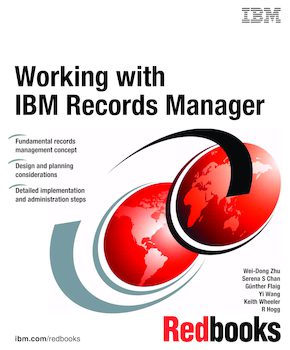Working with IBM Records Manager
An IBM Redbooks publication
Note: This is publication is now archived. For reference only.

Published on 07 August 2007
ISBN-10: 0738489328
ISBN-13: 9780738489322
IBM Form #: SG24-7389-00
Authors: Wei-Dong Zhu, Serena S Chan, Gunther Flaig, Yi Wang, Keith Wheeler, R. Hogg and Yolanda Yates
In a corporate environment, documents are usually created or captured in a decentralized environment with no overall surveillance. Many corporations have no formal process of retaining these documents as records, which can increase storage costs. In addition, when litigation requests occur, companies can spend a huge amount of money and resources to locate records. In the case when a company is not able to locate records or to locate them on a timely manner, the company is subjected to a financial penalty or, more importantly, damage to the company's reputation.
IBM Records Manager is an application and an engine that provides records management capabilities to existing business applications. It provides a single and consistent records management platform to help companies meet government and industry requirements for formal records management.
This IBM Redbooks publication provides an introduction to records management and IBM Records Manager. Solution architects, designers, and implementers who plan to implement IBM Records Manager will find this book useful. It also serves as a guide for system administrators or records administrators in performing common records management administration tasks in IBM Records Manager. Lastly, the first part of this book serves as a good starting point for anyone who is interested in exploring the world of records management.
Part 1. Basic concepts and IBM Records Manager product overview
Chapter 1. Records management
Chapter 2. Retention schedule and a file plan
Chapter 3. Declaration and classification
Chapter 4. Security
Chapter 5. Disposition, discovery, and hold
Part 2. Solution implementation
Chapter 6. IBM Records Manager system components
Chapter 7. Product and solution installation
Chapter 8. File plan creation
Chapter 9. Retention schedule creation
Chapter 10. Profiles and custom attributes
Chapter 11. Declaration and classification configuration
Chapter 12. Search and reporting
Chapter 13. Auditing and monitoring
Chapter 14. Records disposition
Part 3: Appendixes
Appendix A. Function access names, permissions, and their abbreviations